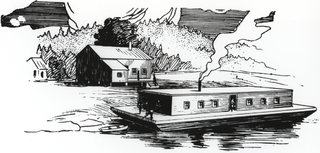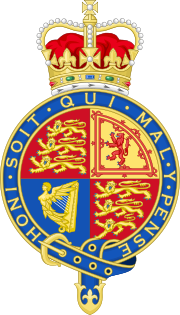An Order-in-Council is a type of legislation in many countries, especially the Commonwealth realms. In the United Kingdom this legislation is formally made in the name of the monarch by and with the advice and consent of the Privy Council (King-in-Council), but in other countries the terminology may vary. The term should not be confused with Orders of Council, which are made in the name of the Council without sovereign approval.
Canadian federalism involves the current nature and historical development of the federal system in Canada.
Pith and substance is a legal doctrine in Canadian constitutional interpretation used to determine under which head of power a given piece of legislation falls. The doctrine is primarily used when a law is challenged on the basis that one level of government has encroached upon the exclusive jurisdiction of another level of government.
In many Commonwealth jurisdictions, the phrase "peace, order, and good government" (POGG) is an expression used in law to express the legitimate objects of legislative powers conferred by statute. The phrase appears in many Imperial Acts of Parliament and Letters Patent, most notably the constitutions of Barbados, Canada, Australia and formerly New Zealand and South Africa.
In Canadian law, a reference question or reference case is a submission by the federal or a provincial government to the courts asking for an advisory opinion on a major legal issue. Typically the question concerns the constitutionality of legislation.
Canadian constitutional law is the area of Canadian law relating to the interpretation and application of the Constitution of Canada by the courts. All laws of Canada, both provincial and federal, must conform to the Constitution and any laws inconsistent with the Constitution have no force or effect.
Section 92(13) of the Constitution Act, 1867, also known as the property and civil rights power, grants the provincial legislatures of Canada the authority to legislate on:
13. Property and Civil Rights in the Province.

Russell v R is a Canadian constitutional law decision dealing with the power of the federal Parliament. The case was decided by the Judicial Committee of the Privy Council, at that time the highest court in the British Empire, including Canada. The Judicial Committee held that the Canada Temperance Act was valid federal legislation under the peace, order and good government power, set out in section 91 of the Constitution Act, 1867. The case expanded upon the jurisprudence that was previously discussed in Citizen's Insurance Co. v. Parsons.

Hodge v R is a famous Privy Council decision on interpreting the Constitution of Canada. This was the first time the doctrine of double aspect was applied to division of powers analysis.

Ontario (AG) v Canada (AG), also known as the Local Prohibition Case, is a significant Canadian constitutional decision by the Judicial Committee of the Privy Council, at that time the highest court in the British Empire, including Canada. It was one of the first cases to enunciate core principles of the federal peace, order and good government power.

Re Board of Commerce Act 1919 and the Combines and Fair Prices Act 1919, commonly known as the Board of Commerce case, is a Canadian constitutional decision of the Judicial Committee of the Privy Council in which the "emergency doctrine" under the federal power of peace, order and good government was first created.

The Canada Temperance Act, also known as the Scott Act, was an Act of the Parliament of Canada passed in 1878, which provided for a national framework for municipalities to opt in by plebiscite to a scheme of prohibition. It was repealed in 1984.

Fort Frances Pulp and Paper v Manitoba Free Press is a famous decision on the Canadian Constitution by the Judicial Committee of the Privy Council on the "emergency doctrine" of the peace, order and good government power in the British North America Act, 1867.

Toronto Electric Commissioners v Snider is a Canadian constitutional decision of the Judicial Committee of the Privy Council where the Council struck down the federal Industrial Disputes Investigation Act, precursor to the Canada Labour Code. The Court identified matters in relation to labour to be within the exclusive competence of the province in the property and civil rights power under section 92(13) of the Constitution Act, 1867. This decision is considered one of the high-water marks of the council's interpretation of the Constitution in favour of the provinces.

The Supreme Court of Canada was founded in 1875 and has served as the final court of appeal in Canada since 1949. Its history may be divided into three general eras. From its inception in 1875 until 1949, the Court served as an intermediate appellate court subject to appeal to the Judicial Committee of the Privy Council in Britain. Following 1949, the Court gained importance and legitimacy as the court of last resort in Canada, establishing a greater role for the Canadian judiciary. In 1982, the introduction of the Canadian Charter of Rights and Freedoms significantly changed the role of the Court in Canadian society, by providing the Court with greater powers of oversight over Parliament and through formal recognition of civil rights including aboriginal rights and equality rights.
Section 91(2) of the Constitution Act, 1867, also known as the trade and commerce power, grants the Parliament of Canada the authority to legislate on:
2. The Regulation of Trade and Commerce.

Canada (AG) v Ontario (AG), also known as In re the Regulation and Control of Aeronautics in Canada and the Aeronautics Reference, is a decision of the Judicial Committee of the Privy Council on the interpretation of the Canadian Constitution. Lord Sankey decided in the case that the federal government has the authority to govern the subject of aeronautics, including licensing of pilots, aircraft, and commercial services and regulations for navigation and safety.

British Coal Corp v R is a decision of the Judicial Committee of the Privy Council in which the authority of the Canadian Parliament to prohibit appeals to the JCPC in criminal cases was upheld.

Nadan v R is a key ruling of the Judicial Committee of the Privy Council in determining the competence of the Parliament of Canada with respect to the restrictions laid out in the Colonial Laws Validity Act 1865, and whether it possessed extraterritorial jurisdiction.

Canada (AG) v British Columbia (AG), also known as the Reference as to constitutional validity of certain sections of The Fisheries Act, 1914 and the Fish Canneries Reference, is a significant decision of the Judicial Committee of the Privy Council in determining the boundaries of federal and provincial jurisdiction in Canada. It is also significant, in that it represented a major victory in the fight against discrimination aimed at Japanese Canadians, which was especially prevalent in British Columbia in the early part of the 20th century.







